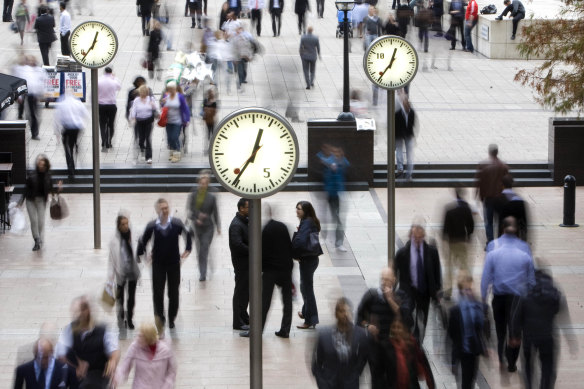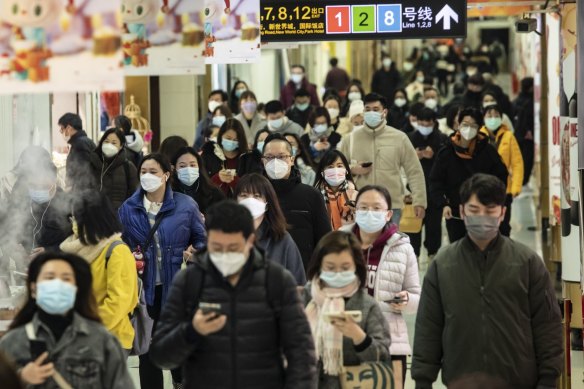The world is in a precarious position

Save articles for later
Add articles to your saved list and come back to them any time.
With most of the major economies experiencing unsustainable inflation rates and their central bankers responding by imposing crushing interest rates, it’s not surprising that the World Bank has described the state of the global economy as “precarious.”
That was the description the bank used in its latest global economic prospects report, issued on Tuesday, in which it forecast that, after growing 3.1 per cent last year, growth would slow substantially to 2.1 per cent this year and only recover marginally, to 2.4 per cent, in 2024.
Interest rates in the advanced economies are likely to remain high for some time, even if it appears that in most economies inflation rates have peaked.Credit: Bloomberg
Its forecast for advanced economies is even gloomier. After growing 2.6 per cent last year they are expected to slow to a near flat-lining 0.7 per cent growth rate this year and then post a weak recovery to only 1.2 per cent in 2024.
The bank cited the protracted effects of the negative shocks of the pandemic, the war in Ukraine and the “sharp” tightening of monetary policies to contain inflation for what it expects to be a significant slowing of growth in the second half of this year that will spill into 2024.
It’s now fairly well understood that the fiscal and monetary splurges in response to the pandemic ignited consumer demand for goods that, when combined with the severe disruptions to global supply chains wrought by the pandemic, ignited inflation at levels not seen for decades.
Central bankers were complacent, thinking that the spike in inflation would subside once the worst of the pandemic’s effects passed. Governments kept the fiscal binge going too long and have subsequently left the heavy lifting in response to elevated inflation rates almost entirely up to their central banks.
That’s why the US Federal Reserve has presided over the most aggressive shift in US monetary policy in 40 years and why our Reserve Bank has raised its cash rate 12 times in a cycle that started just over a year ago. It warned this week, when announcing the latest rate rise, that there might be more rate rises to come.
A recent paper by former Fed governor Ben Bernanke and the Peterson Institute for International Economic’s Oliver Blanchard has pointed to the next potential source of pressure on rates.
They argue that, while the unexpected strength of demand during the pandemic, fuelled by the easy fiscal and monetary policies, tightened labour markets it didn’t contribute significantly to inflation, at least initially. Inflation has been largely driven by product markets.
Now, however they say that the effects of tight labour markets are starting to emerge and are likely to grow unless policies that bring labour demand and supply into better balance are pursued.
China’s recovering economy is crucial to driving a global rebound.Credit: Bloomberg
That’s an issue that is now building within the Australian economy as the union movement seeks to recover the real declines in wages caused by the high inflation rates.
Without compensating productivity gains, that risks a wages/prices spiral that would force interest rates higher for longer than they might otherwise have been.
The new and unusually assertive campaign by the business lobby groups against the Federal Government’s “same jobs, same pay” changes to workplace laws, and continuing angst about the multi-employer bargaining regime the government introduced last year, relate to concerns that their profitability, incentive to invest and competitiveness will be undermined by higher wage costs in the absence of productivity offsets.
Even without the risk of a wages’ breakout, interest rates in the advanced economies are likely to remain high for some time, even if it appears that in most economies inflation rates have peaked.
In the US, where the Fed’s actions have global implications that are largely transmitted through their impact on the US dollar, the central bank is expected to pause its rate-hiking cycle this month but could have at least one more 25 basis point increase left.
Central bankers, confronted with the levels of inflation now being experienced, will always tend to err on the side of caution.
The Fed, and RBA, are likely to maintain tight monetary policies until there is clear evidence that inflation is returning to their targeted levels of around two to three per cent.
A “known unknown” for central banks is that they know monetary policy works with a lag but the extent of the lag is unknown. It’s impossible for them, or anyone else, to know whether they’ve already done enough to break the back of their inflation rates or whether they need to be even more aggressive.
Soaring inflation has driven down real wages in Australia.Credit: Tamara Voninski
Another uncertainty is what impact the policies of the advanced economies, particularly America’s, will have on the rest of the world. The World Bank said that rising borrowing costs in advanced economies could lead to “financial dislocations” in more vulnerable emerging market economies.
There are also unintended side effects from a rapid tightening of monetary policies.
The US regional banking crisis, which spilled into Europe and forced the distressed sale of Credit Suisse to UBS, was a direct consequence of the impact of the Fed’s rate hikes and withdrawals of liquidity on bond markets. There could be, and probably are, less visible but destabilising impacts occurring within the non-bank financial sectors of the developed economies.
In Australia, where bank regulation is now arguably as tough as, if not tougher than, anywhere in the world, the strength of bank capital and liquidity is such that there is unlikely to be the stress-related events seen in other jurisdictions.
Reducing demand for credit and, inevitably, rising loan losses will, however, make both lenders and borrowers more cautious, which will contribute to lower growth.
The Fed, and RBA, are likely to maintain tight monetary policies until there is clear evidence that inflation is returning to their targeted levels of around two to three per cent.
The more positive note in the World Bank’s forecasts for Australia was its expectation that, after its zero-COVID policies lowered its growth rate to 3 per cent last year, China’s economy will grow by 5.6 per cent this year.
That’s roughly in line with China’s official target of “around five per cent” but above a lot of private sector forecasts that see the GDP growth number starting with a four.
Whether a trade-dependent China can actually deliver that kind of number in a world where trade volumes expected to grow only 1.7 per cent this year (after growth of six per cent last year) is probably dependent on whether or not it can boost consumption.
Most of the recent economic data suggests that, after an initial bounce when Beijing lifted the COVID restrictions, growth has faltered. Activity in its manufacturing sector is contracting, its property sector remains depressed and youth unemployment is above 20 per cent.
China remains the dominant market for Australian resources so weaker growth – and the price declines that have already been occurring as global growth has slowed – would unwind the major boost to the Australian economy from the resource sector that was seen in last year’s federal budget outcomes.
In the circumstances, with the fight against inflation yet to be won and the impact of the surges in interest rates and broader tightening of monetary conditions yet to be fully felt within both the global and domestic economies, “precarious” seems an apt description of the current state of the world, and Australia.
The Business Briefing newsletter delivers major stories, exclusive coverage and expert opinion. Sign up to get it every weekday morning.
Most Viewed in Business
From our partners
Source: Read Full Article



